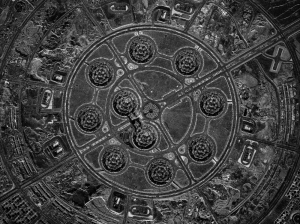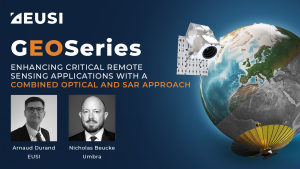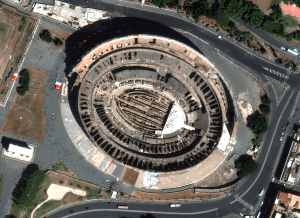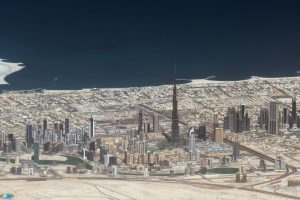Ensuring Food, Farming, and Fairness
- European Space Imaging
- 30 January, 2014
The Common Agricultural Policy (CAP) of the European Union is in place to ensure a fair standard of living for farmers through subsidies and other income support; provide a safe, stable and affordable food supply for consumers; and help balance development of rural areas throughout the continent. In Ireland, the Department of Agriculture, Food & Marine is responsible for the task of identifying parcels eligible for the program.
Detecting ineligible land features
Each year under the Single Payment System, farmers across the European Union are paid a subsidy based on the amount of land they actively farm. Land that has gone to scrub or where buildings or roadways have been put in place is considered ineligible. The Agriculture Ministry’s task is to identify those parcels where a change of use has taken place that no longer makes them eligible for subsidies under the
guidelines of the program.
“It is an ongoing and complex task that relies on a great deal of human intervention and interpretation,” explains Jason Parker, GIS technician for Dublin-based ICON, a European Space Imaging reseller. “The Ministry sought to develop a land parcel identification system database that could quickly and more automatically identify specific features of the landscape that do not qualify for payment under the program.”
Pilot program put in place
With the long-term goal of implementing a countrywide repeatable and consistent approach to imagery analysis and change detection, the Ministry asked ICON to develop a process that deployed an object-based image analysis scheme that would more fully automate the process, reducing the need for human interpretation and increasing both the accuracy and efficiency of the process. In March 2012, ICON embarked on a pilot project involving eleven 1.5 x 1.5 kilometer sites in the west of the country where the land is typically poor in agricultural quality with a lot of scrub. WorldView-2 was tasked with collecting the imagery.
“The objective of the pilot was to fully exploit the capabilities of the WorldView-2 eight-band dataset by extracting the most meaningful information from its remotely sensed data to speed imagery analysis and change detection,” Parker says.




Initial results indicate success
Once captured by WorldView-2, image objects, grouped by shape and texture, were created over four levels with each level having a finer segmentation than the level preceding it. Image classification is performed in three groups with each group using different features of color from the red, green, blue and nearinfrared bands, as well as various texture and vegetation indices.
“We basically used a bottom-up approach that essentially passes a series of filters over the image,” Parker explains. “The preliminary results indicated that the greatest accuracy comes from classification processes that utilize a combination of color and texture features that allow us to distinguish water, buildings and shadows.”
Creating a model of repeatability and consistency
Phase two of the project, incorporating even more data sources and upgrades and enhancements to the system’s analysis programs, are just getting underway. The end goal is to create a repeatable, consistent land parcel identification model that can be used in a variety of both rural and urban settings and adapted for use across the country and even the Continent.
"The first pilot project gave us great insight and direction to move forward and refine the model to cost-effectively create the consistent and repeatable system that can be applied to many environments, including urbanized areas where variables and rates of change are even greater, as well as to other countries across continental Europe."
Challenge
Create a cost-effective, consistent and repeatable methodology to identify land parcels where a change of use has taken place making them ineligible for EU government farm subsidies.
Solution
ICON deployed WorldView-2 high resolution satellite imagery across eleven 1.5 x 1.5 kilometer sites to demonstrate the technology’s ability to accurately extract ineligible land features.
Results
This broad-based solution not only speeds imagery analysis and change detection, but also creates a scalable, repeatable and consistent approach to the process.
ABOUT ICON
Established in 1994, Dublin-based ICON Group has a high level of expertise in handling data and information, and in building and re-engineering database systems. Continuously developing and updating its range of services, ICON has particular expertise in working with Irish data sets and has a strong grounding in dealing with spatial data.
Related Stories

What is SAR Imagery? Introduction to Synthetic Aperture Radar
SAR imagery enables all-weather monitoring, penetrates dry soil, and offers resolution as high as 25 cm. Thanks to that, it’s invaluable for applications like emergency response, defence and intelligence, or agriculture. How does SAR work? What are its advantages and limitations? And what other data sources can you integrate it with? Read the article to learn more.

Enhancing Critical Applications With A Combined Optical and SAR Approach
For the first time in history, users can schedule synchronised collections of 25 cm SAR and 30 cm Near Real-Time optical imagery to mitigate weather and gain deeper insights of events unfolding on the ground. This is especially valuable for Emergency Response, GEOINT and other applications.

18 European Landmarks in Satellite Images
Satellite sensors captured unique architecture, breathtaking nature and centuries of history. Explore the Colloseum, La Sagrada Familia, the Leaning Tower of Pisa, and other landmarks.

Understanding ONA in Satellite Imagery: What is Off Nadir Angle and What Is It Used For?
Off Nadir Angle (ONA) plays a crucial role in the quality of optical satellite imagery. It influences its resolution and clarity, decides the visibility of features, and makes it easier or harder to identify objects. Moreover, ONA is used to create stereo imagery and 3D models of the Earth’s surface. Read on to learn more.





